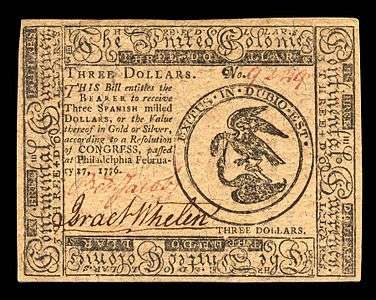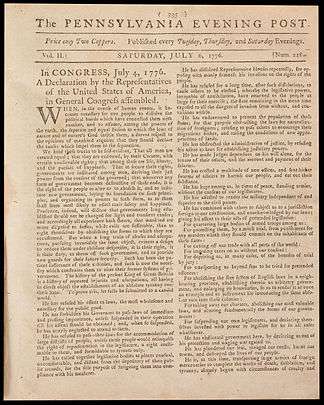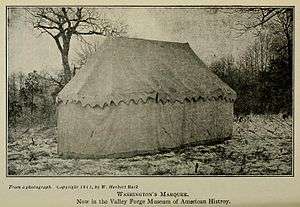Museum of the American Revolution
 | |
| Established |
2000 April 19, 2017 |
|---|---|
| Location | Philadelphia, Pennsylvania |
| Coordinates | 39°56′54″N 75°08′45″W / 39.9484°N 75.1458°WCoordinates: 39°56′54″N 75°08′45″W / 39.9484°N 75.1458°W |
| Type | History museum |
| Collection size | 3,000[1] |
| President | Michael C. Quinn |
| Website | www.amrevmuseum.org |
The Museum of the American Revolution (formerly The American Revolution Center) is a Philadelphia museum dedicated to telling the story of the American Revolution. The museum was opened to the public on April 19, 2017, the anniversary of the first battle of the war, Lexington and Concord, on April 19, 1775.[2]
Overview
The museum owns a distinguished collection of several thousand objects including artwork and sculpture, textiles and weapons, manuscripts and rare books. Permanent and special exhibition galleries, theaters and large-scale tableaux will bring to life the original "greatest generation," and engage people in the history and continuing relevance of the American Revolution.
The museum serves as a portal to Philadelphia's other Revolutionary landmarks, enriching the existing heritage community and making Philadelphia an engaging and authentic destination for those interested in discovering America's founding.
The President and CEO is Michael C. Quinn and General John P. Jumper serves as the Chairman of the Board of the Directors. Philadelphia area media entrepreneur and philanthropist H.F. “Gerry” Lenfest served as Chairman of the Board of Directors from 2005 until 2016 and was instrumental in leading the Museum to its opening in 2017. [3]
Location
The museum is located in the historic heart of Philadelphia, the city that served as the headquarters of America's founding. The site is across the street from the First Bank of the United States and two blocks from Independence Hall, the National Constitution Center, Second Bank of the United States, American Philosophical Society, Carpenters' Hall, and the Liberty Bell.
Design and construction
On June 12, 2012, architect Robert A. M. Stern unveiled designs for the permanent location.[4] Groundbreaking for the museum occurred in fall 2014.
The museum rises three stories above the street and, with a full basement, encompasses 118,000 total square feet, with 32,000 dedicated to exhibits and interpretive spaces. The first floor includes a museum shop and the Cross Keys Café which opens to the sidewalk. The first floor interior is organized around a skylit central interior court and features a cross-vaulted ticketing lobby, a multi-use theater and a changing exhibition gallery. The second floor features 18,000 square feet of galleries and a theater dedicated to the exhibition of George Washington's marquee tent. The museum's third floor offers rooms for events and two terraces overlooking the First Bank of the United States, Independence National Historical Park, and the Philadelphia skyline beyond. The museum is seeking Leadership in Energy and Environmental Design (LEED) Silver certification.[5]
The museum opened on 19 April 2017.
Outdoor plaza
The Museum's outdoor plaza opened on 25 September 2016. It is accessible to both museum visitors and to passersby, and feature dramatic installations of Revolutionary War artifacts, bronze sculpture, shaded seating, and – once the museum building opens, seasonal cafe seating.[6]
Exhibits
Visitors follow a chronological journey from the roots of conflict in the 1760s to the rise of armed resistance, the Declaration of independence of 1776 through the final years of the war. Visitors see the diversity of revolutionary-era Americans and their opinions, for example by viewing an Oneida Indian council house, and the 1773 volume "Poems on Various Subjects" by Phillis Wheatley, America's first published black female poet.
Several immersive gallery experiences feature a full-scale replica of Boston's Liberty Tree, the recreation of an Oneida Indian Council, the Battlefield Theater featuring the Battle of Brandywine, a recreation of Independence Hall, and a large model of an 18th-century privateer ship. A dedicated theater houses one of the most iconic surviving artifacts of the Revolution: General Washington's Headquarters Tent, which served as both his office and sleeping quarters throughout much of the war.
The Museum's Director of Collections and Exhibitions, Dr. R. Scott Stephenson holds an M.A. and Ph.D. in American History from the University of Virginia. Dr. Stephenson is a specialist in colonial and revolutionary American history and material culture with a background in visual storytelling. Also supporting the exhibition process is Dr. Philip C. Mead. He holds an M.A. and Ph.D. in American History from Harvard University.
Other historians who have been consulted on the project include: Richard Beeman (University of Pennsylvania), Vincent Brown (Harvard University), Thomas Chavez (National Hispanic Cultural Center), Thomas Fleming (writer and novelist), James Hattendorf (US Naval War College), Don Higginbotham (University of North Carolina), Pauline Maier (Massachusetts Institute of Technology), Holly Mayer (Duquesne University), Thomas McGuire (Malvern Preparatory School), David McCullough (Yale University), Gary Nash (University of California, LA), Ray Raphael (University of California, Berkeley), Matthew Spooner (Columbia University), Laurel Thatcher Ulrich (Harvard University), and Gordon S. Wood (Brown University).
Collection
The Museum of the American Revolution has a collection of several thousand objects. The museum's collection includes items owned and used by General George Washington during the War of Independence, an extensive collection of historic firearms and edged weapons, important art, important manuscripts, and rare books. The collection started by Rev. W. Herbert Burk in the early 1900s makes up the core of the collection.[7]
Some items have been displayed at George Washington's Mount Vernon, Valley Forge National Historical Park, the National Constitution Center, the Winterthur Museum, the Senator John Heinz History Center and the North Carolina Museum of History. [8]
Highlights include:
- George Washington's tent[9]
- Silver camp cups from Washington's field equipment[10]
- Wartime correspondence and books from Washington's library
- The thirteen-star flag known as the Commander-in-Chief's Standard
- The fowling piece carried by Captain David Brown, leader of a company of minutemen from Concord, Massachusetts, and a British military musket carried by a soldier of the 4th (King's Own) Regiment of Foot, both of whom participated in the first battle of the War of Independence, April 19, 1775.
- A Dreadful Scene of Havock, Xavier della Gatta’s painting of the Battle of Paoli
- The Battle of Germantown, by Xavier della Gatta (1782)
- William B. T. Trego’s iconic 1883 painting The March to Valley Forge.[11] (Currently on loan – displayed at the Valley Forge National Historical Park Visitor Center, as of March 2013)[12]
- Soldiers’ letters and orderly books as well as volumes owned by Patrick Henry, George Mason and other founders
- Volume of ancient Roman history by the author and historian Livy, owned by George Mason[13]
- A copy of the first newspaper printing of the Declaration of Independence, printed by the Pennsylvania Evening Post on July 6, 1776[14]
- British plan of the Battle of Brandywine[15]
- Hessian headgear[16]
Selections from the collection
 The March to Valley Forge. William B. T. Trego (1883)
The March to Valley Forge. William B. T. Trego (1883) Continental Currency (1776)
Continental Currency (1776)
 First newspaper printing of the Declaration of Independence (1776)
First newspaper printing of the Declaration of Independence (1776) Plan of the Battle of Brandywine (1777)
Plan of the Battle of Brandywine (1777)
Awards
In 2012 the museum received the MUSE Award (Silver level) from the American Alliance of Museums in the category of Mobile Applications, recognizing the museum's American Revolution Interactive Timeline iPad app.[17]
References
- ↑ "Washington’s Wartime ‘Oval Office’ Getting Remade For Philadelphia Museum". CBS Local (Philadelphia). 31 March 2013. Retrieved 6 April 2013.
- ↑ "Museum of the American Revolution to Open April 19, 2017". Museum of the American Revolution. June 16, 2016.
- ↑ "Board of Directors". Museum of the American Revolution. Retrieved 31 March 2013.
- ↑ Pogrebin, Robin (11 June 2012). "Design Shown for Museum of American Revolution". The New York Times. Retrieved 2 April 2013.
- ↑ "Museum of the American Revolution". Robert A.M. Stern Architects – Official Website. Retrieved 2 April 2013.
- ↑ Kenneth, Hilario (29 August 2016). "Upcoming Revolution Museum to open outdoor plaza before 2017 debut". Philadelphia Business Journal. Retrieved 29 August 2016.
- ↑ Ferguson, Andrew (1 May 2017). "Immerse Yourself in 1776 and All That". Weekly Standard. Retrieved 25 April 2017.
- ↑ Mason, ZeeAnn (19 May 2011). "Rare Objects from American Revolution Center Collection On Display Through Loans to Historic Mount Vernon and the National Constitution Center" (PDF) (Press release). Philadelphia, Pennsylvania: American Revolution Center. Retrieved 2013-04-07.
- ↑ Nye, James (31 July 2012). "Washington's tent among stunning artifacts in first ever museum dedicated to American Revolution". Daily Mail. Retrieved 31 March 2013.
- ↑ "Washington's Camp Cups". Museum of the American Revolution. Retrieved 31 March 2013.
- ↑ "The March to Valley Forge". Museum of the American Revolution. Retrieved 31 March 2013.
- ↑ "Restored Painting Now on Display at Valley Forge Visitor Center". Phoenixville Patch. 15 January 2012. Retrieved 7 April 2013.
- ↑ "A Founding Father's Roman History". Museum of the American Revolution. Retrieved 31 March 2013.
- ↑ "First Newspaper Printing of the Declaration". Museum of the American Revolution. Retrieved 31 March 2013.
- ↑ "Plan of the Battle of Brandywine". Museum of the American Revolution. Retrieved 31 March 2013.
- ↑ "Hessian Headgear". Museum of the American Revolution. Retrieved 31 March 2013.
- ↑ Miller, Aaron. "2012 AAM MUSE Awards". Bluecadet. Retrieved 1 April 2013.

